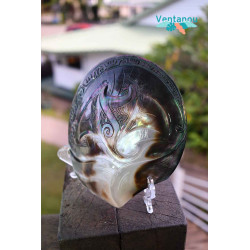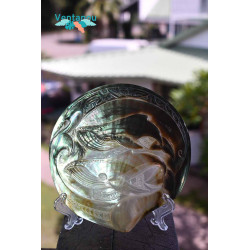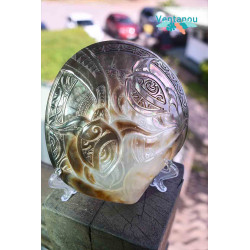Mother of Pearl & Carved Bone Polynésie
French Polynesia is an open-air museum for art and culture enthusiasts. Its islands abound in handcrafted creations, reflecting the richness and diversity of the local heritage. Among these marvels, the mother-of-pearl and bone sculptures are captivating both for their beauty and the emotion they evoke.
These exceptional pieces are the result of ancestral know-how, a legacy carefully handed down from generation to generation. They embody the beauty, strength and spirituality of the Polynesian spirit.
Through this online store, we take you on a journey of discovery into the history, symbols and techniques of mother-of-pearl and bone carving. We'll also share tips on how to select and acquire authentic carvings when shopping for Polynesian crafts.
Mother-of-pearl sculpture, an ancestral art at the heart of Polynesian culture!
Mother-of-pearl and bone carving, practiced since time immemorial in Polynesia, illustrates the creativity, finesse and spirituality of its peoples. This ancestral art is deeply rooted in the culture of the Pacific Ocean, bearing witness to traditions and skills handed down from generation to generation.
The origins of mother-of-pearl and bone work
Polynesians have developed remarkable expertise in the use of mother-of-pearl and bone, natural materials derived respectively from shellfish such as pearl oysters, abundant in the lagoons, and marine animals such as whales, sharks or turtles, deeply venerated in their culture. These materials are worked with simple but effective tools, such as bamboo blades, polished stones or shark teeth, resulting in sculptures of great precision and delicacy.
The symbolism of Polynesian motifs
In the art of Polynesian mother-of-pearl and bone carving, each motif is the expression of a rich symbolism: elements of nature, animals, divinities or ancestors. The tiki, for example, is an emblematic Polynesian symbol representing man, god or guardian. A symbol of protection, strength and fertility, it can be found both on pendants and on sacred sites such as marae. The turtle symbolizes longevity, wisdom and peace, while the whale evokes power, generosity and freedom, and the manta ray, elegance, beauty and grace.
The importance of sculpture in local craftsmanship
Essential to local craftsmanship, mother-of-pearl and bone carving reflects the identity, culture and history of the Polynesian islands. They represent not only a means of artistic expression, but also a vehicle for the transmission of immeasurably rich ancestral know-how. These authentic, one-of-a-kind sculptures are distinguished by their quality, originality and value, captivating collectors, art lovers and travelers from all over the world. They embody an unforgettable memory of Polynesia, recalling the magic and beauty of these paradise islands.<
A fusion of modernity and tradition
Polynesian craftsmen excel at blending ancestral heritage with the spirit of the times, creating pieces that are both original and timeless. Relying on traditional methods enriched by the use of modern tools and combinations with other materials such as wood, jade, coral or silver, they reinvent their art.
This innovative approach results in collections of jewelry, sculptures and objets d'art that are not only unique, but also elegant.
Traditional manufacturing methods
The creation of mother-of-pearl and bone sculptures is a meticulous process that values time, patience and expertise. The craftsmen, custodians of age-old techniques, carefully select their materials to give them a second life through cleaning, cutting, polishing and assembly.
Using traditional tools such as bamboo blades, stones or shark teeth, they shape mother-of-pearl and bone with extraordinary precision and delicacy, giving life to captivating works of art. The sculptures, often engraved with symbols, images and stories, tell the essence of Polynesian mythology and culture.
Polynesian mother-of-pearl and bone sculpture must-haves
Searching for local crafts will allow you to explore the rich tradition of Polynesian mother-of-pearl and bone carving, offering an impressive diversity of shapes, colors and messages. Whether your quest is for a unique piece of jewelry, a decorative object or a memorable souvenir, the unique works of local artisans will capture your heart.
Carved mother-of-pearl: Varieties and meanings
Derived from shellfish, notably pearl oysters, mother-of-pearl is a noble material that seduces with its shine, smooth texture and unique iridescent reflections. Artists work it in a variety of patterns and sizes, reflecting both tradition and modernity.
Common symbols, such as the tiki, turtle, whale or manta ray, carry profound meanings in Polynesian culture.
The tiki, for example, is a symbol of protection, strength and fertility, embodying man as divinity or guardian. Carved mother-of-pearl jewelry and decorative objects, such as pendants, bracelets, earrings, lamps and statuettes, are endowed with this symbolism-rich essence.
Shopping in Polynesia: Tips for choosing and buying authentic sculptures
Are you captivated by the elegance and detail of Polynesian mother-of-pearl and bone sculptures?
Would you like to take home a unique and precious souvenir of your stay in Polynesia?
Here are some key tips for finding and acquiring authentic carvings that truly celebrate Polynesian art and culture.
Where to find mother-of-pearl and bone sculptures in Polynesia?
French Polynesia offers a multitude of places to admire and purchase mother-of-pearl and bone sculptures. Especially in local markets, you'll find a variety of stalls run by artisans offering jewelry, pendants, statuettes and much more. Art galleries, specialty stores and cultural establishments also feature more sophisticated and original works.
If possible, meeting the artists in their studios will give you an insight into their expertise and passion.
Quality criteria to watch out for.
Choosing a quality Polynesian mother-of-pearl and bone sculpture requires careful attention to several criteria. First and foremost, the materials used must be natural and local. Mother-of-pearl ideally comes from the shells of Polynesian lagoons, and bone from marine animals respected by local culture.
The finesse and precision of the carving, carried out with traditional tools and ancestral techniques, are also crucial. The finished piece must be smooth, shiny and impeccable.
It's important to appreciate the beauty and significance of the motif, inspired by Polynesian mythology and symbolism. The motif must be harmonious, expressive and rich in messages.
Contribute to the local economy by buying authentic works of art
Buying a Polynesian mother-of-pearl and bone sculpture contributes to supporting the local economy and promoting the island's art and culture. By opting for authentic works, you support the talent of local craftsmen and help to preserve and pass on Polynesia's unique cultural and artistic heritage.
What's more, you're helping to avoid supporting the counterfeit market, thus preserving the quality and originality of Polynesian sculptures. This responsible action guarantees you'll leave with a memorable souvenir of Polynesia.
Mother-of-pearl carving or bone carving, there's a style for everyone.
Polynesian mother-of-pearl sculpture is an ancestral, symbolic and authentic art form, embodying the beauty, strength and spirituality of Polynesian culture. These creations are true marvels, capturing both visual and spiritual admiration, and are unforgettable souvenirs of a trip to Polynesia.
To acquire these Polynesian bone sculptures, we recommend visiting online stores, art galleries or artisans' workshops. It's important to find out about the provenance, quality and significance of the pieces to help promote Polynesian art and support its local economy.
Allow yourself the pleasure of acquiring a Polynesian mother-of-pearl and bone sculpture, a unique and precious gift for yourself or your loved ones.


